#ur little critter swings both ways
Text

i said i’d do these in order but this is so funny hehehehxbxbfjc
s2ep15- the trouble with tribbles
they appear to be bisexual
#boogershirt#leo posts#just bisexuals in the pic 🥰🥰#ik they meant that they could reproduce independently but this is so funny#ur little critter swings both ways#star trek#tos#the trouble with tribbles#jim kirk#kirk#bisexual#im going to do this a second time when i get to it
34 notes
·
View notes
Text
June Feature: Top 10 Harmony URs for Johnny
Those of you unfamiliar with the CCG player archetypes which were first established for Magic: the Gathering may be unfamiliar with the significance of this article’s title. I would advise you to take a quick look around the Internet for some explanations, of which there are many. While attempting to break down any broad population into clean categories is always a tricky exercise, the Magic archetypes have been pretty successful over the course of their tenure. And that’s why I start writing this article and tell you that I really am a Johnny player. (Except for the few short weeks around cons when Spike shows up a little.) I love being challenged by cards, and seeing puzzles that can be solved. A card that’s just straight-up good isn’t much fun. It’s the cards that you have to work with, to tease out in just the right way to reveal their beauty, those are the good ones.
So what follows is most definitely not a list of my Top 10 URs in Harmony. What follows instead is a list of my Top 10 URs for Johnnys. I settled on three criteria for cards that I would use to judge which ones fell under the label:
Cards that apply symmetric effects, i.e. things that are either a boon or a penalty to both players. The trick with these cards is usually to build a deck that ignores the penalty or consistently takes advantage of the boon.
Cards that create “side-grade” effects, which aren’t obviously useful on their face. Giving more power or extra colours is an obviously useful thing. Changing traits on other cards is not so obviously useful.
Cards with powerful abilities that are locked behind significant restrictions. For these, the trick is building a deck that can consistently get around those restrictions and show off the true power of the card beneath.
I’ve limited this list to only Ultra Rares firstly to limit the work I had to do putting it together, but also because URs are generally where we expect to find strange, quirky cards that might fit the criteria listed above. Ultra Rares are so very rarely simple that there’s always a wealth of experimentation to be done in nearly every new set. And sure, sometimes you get a Staff or a Carbo Loader that just goes in everything, but then those cards just won’t make the list. So let’s get to it.
#10 Philomena, Bird of a Feather (PR)
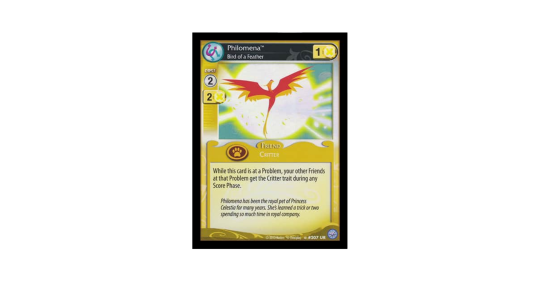
Way back in Premier, we got the first card in the game that was capable of altering the traits of other cards. We didn’t get another one until Absolute Discord, which honestly is a bit of a shame. Philomena’s role in creating Critters specifically during the Score Phase has admittedly only a few limited uses, but those uses are still pretty cool. A good choice these days is something like Cratus, which with Philomena can retire any Friend at the Problem for the point (including Cratus itself, if that’s needed at any time). In her time, though, Philomena suffered from not having very many cards that could take advantage of her effect. Only Goldie Delicious, Cat Hoarder (CN) and Beast Bulk Up (AD) really fit the bill. But this still is a card that I keep in the back of my head.
#9 Starlight Glimmer, Enforced Equality (EO)

Oftentimes, the best cards happen when flavour aligns with power. “Big Glimmer” here, as I’ve affectionately nicknamed her, is an impressive confluence of the two concepts. Forcing all characters at her Problem down to an equal two Power is of course wonderfully flavourful, and at the same time it creates a card with a built-in choice. Starlight does something that very few Epics in the game do: she stymies traditional Farming decks while still being viable for non-traditional Farming decks to use. Wide styles like Thorax or unorthodox styles like Professor Sparkle can take advantage of her two points just fine, while Applejack is left with naught to rely on but a flip. Personally, I think we could use a fair bit more of cards like this.
#8 Ember, Up to the Challenge (DE)
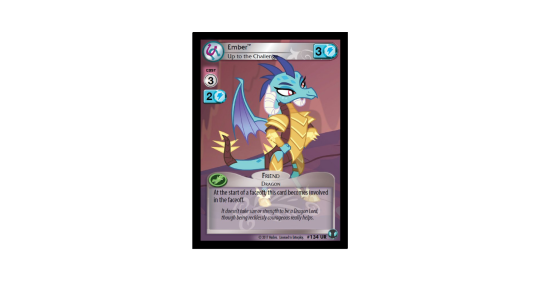
Another thing which can often be appreciated about card design is when we get a card with an amount of elegance to it, and as much as Ember herself might object to being called elegant, this is a card which wraps up a nice amount of flavour, too. Of all the cards on this list, this is probably the most straightforwardly powerful one. Ember’s ability to boost your power in any faceoff, regardless of location or who started it or anything, is just great. But I simply can’t get over the comparison between this card and a card like Spitfire, Drilling it In (DE). Rather than having a veritable pile of abilities to overwhelm you with her utility, Ember has just one nice, clean ability, but you’ll still be overwhelmed by the number of things that you can do with her.
#7 Trenderhoof, Trailblazer (AD)
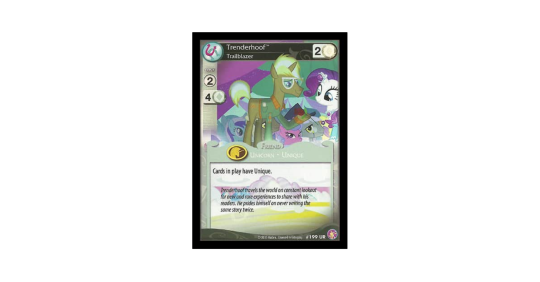
Now, sure, this card has caused a lot of trouble for the game, so you could certainly start a legitimate debate about whether or not Trailblazer is actually a well-designed card. It’s certainly an audacious card, in its extreme potentially encouraging some sort of quasi-Highlander deck that finds a way to consistently get Trailblazer into play to mess with the opponent’s plays. In this way, it’s a perfect example of Criterion 1 above: a symmetrical effect that you really have to build around to take advantage of. The combo decks which have utilized him did just that, taking advantage of the game’s rules to allow free dismissals on their own Friends. Again, we can talk separately about the decks that this card has enabled, but any card that allows tinkering around with the rules in that way is cool in my book.
#6 Pinkie Pie, Distracting Cheerer (CG)
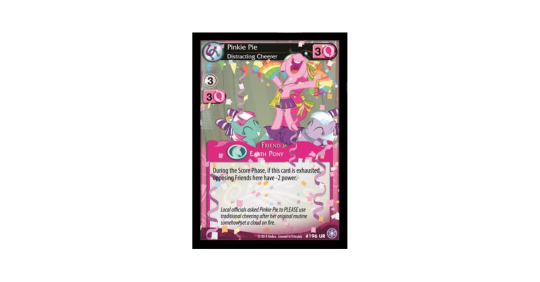
Distracting Cheerer really is the epitome of Criterion 3 above, a powerful effect that can really swing a turn, but with the chief restriction that the card itself has no built-in way to activate the effect. Essentially, Distracting Cheerer gives us a lock, and we have to build a deck that can consistently provide the key. And there are a whole bunch of different ways that you can do this. Orange-Pink might like it a lot, actually, exhausting Pinkie to Muffin Mare maybe, and crushing a resulting faceoff because of it. Or you could stretch into some other colours to make it work. Either way, Pinkie Pie simply demands creativity in her use, and that means that there’s a real payoff for players like me, when we can make her work.
#5 Nightmare Star (AD)

In many respects, Nightmare Star is exactly what I would think an Epic Troublemaker should be: a high-powered Troublemaker with a big point score and a global effect that neither player can ignore. Sometimes, Nightmare Star can just wreck a deck, eliminating the usefulness of most of its key tools, especially these days with so many AT-generators running around. Meanwhile, of course, the challenge is on the player running NMS to insulate themselves against the effect. The card provides a big modification to the way that the game is played, but it’s totally possible to protect yourself from it with your build. Which is to say, it’s pure Johnny.
#4 Fluttershy, Hide and Squeak (AD)
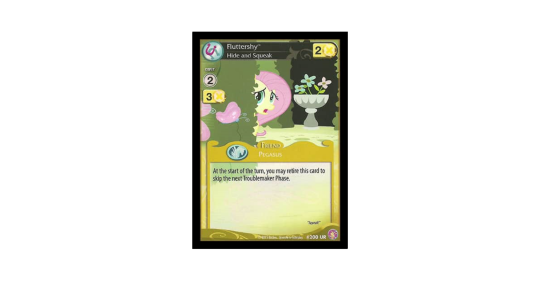
There’s a lot of Absolute Discord on this list, I think mostly because that was a set where Enterplay really pushed the limits on creative card design. You want to talk about a card that creates an enticing puzzle to solve? There’s only one card in the game that I find more fascinating, and you’ll see it soon enough. Hide and Squeak presents the possibility of a Holy Grail of Troublemaker control: never having to care about Troublemaker-faceoffs at all. The puzzle, of course, is finding a way to effectively cycle Fluttershy out of the discard pile and back into play for the next turn. There are some cool ways of doing it, but everything I’ve found so far is pretty AT-expensive. Either way, Fluttershy is the Queen of Criterion 3.
#3 Sunset Shimmer, Clever Girl (AD)

Clever Girl is, admittedly, a touch mainstream for this list. She did see some play, after all, in the days of Absolute Discord, when extra AT was very much at a premium, especially compared to where we are now. But what really excites me about cards are the possibilities for the interesting choices that they could create. Most of the cards on this list create those choices during the process of deck construction, but Clever Girl brings that choice right into the game itself. Her ability essentially allows you to sacrifice card advantage for AT, which makes her a fine example of Criterion 3. What’s more important at the instant the trigger fires? And, as with any good Johnny card, can you build your deck in a way that mitigates her costs and takes full advantage of her benefits?
#2 Starlight Glimmer, Chrono Trigger (MT)

Much of what was said earlier for Nightmare Star surely applies here, but if you thought that Nightmare Star was a just a minor annoyance, here we have a card that literally demands your attention. Because if you leave it be, eventually it is going to fundamentally change the game that is being played. Even before you think about how to play with it, you’ve got to make a fundamental choice in including it in your deck: do you want it to go off? Are you trying to potentially cheat out a bunch of powerful cards, or are you trying to use it to mill your opponent at accelerated speed? Or maybe you just want to beat it up (clearly you just don’t know how to have fun). Once that’s done, then you can start solving the problem of how to actually play it properly.
Now, before we get to #1, I’m going to build some suspense by quickly touching on a couple of Honourable Mentions:
Twilight Sparkle, Noted Speaker (CN)
A classic example of Criterion 2, Noted Speaker is a card that changes a lot about the game when it’s in play. Both you and your opponent know what your faceoff flips are going to be. You have a huge incentive to participate in some top-deck shenanigans, too.
The Equestria Games (CG)
The Equestria Games is another classic example of Criterion 1, giving us a huge potential effect, but one that’s fully symmetrical with the opponent. These days, I could consider maybe a Magical Misfire right before popping Games. Wait, now that’s an idea, isn’t it...
Well, that’s enough for stall tactics. Let’s get on to the big one:
#1 Flutterbat (CN)

As an enticing, cool puzzle, Flutterbat is on a level entirely her own. The card is flavourful to a fault, throwing away nearly any chance at being useful so that it can emphasize itself as a flitting, standoffish Troublemaker that just wants to be left alone. Attempting to make Flutterbat work for you is an exercise in and of itself, involving manipulating the board in an attempt to get her to move when you want her to. It’s so hard that one might even dismiss the effort as not worth it. Here, though, I might ask you to remember that there was another Canterlot Nights UR that was dismissed as nothing more than a joke when first printed, and that story ended up lasting for a long time indeed. But even beyond that, Flutterbat is a challenge without equal. Getting her to work inside a deck would be a crowning achievement, and something I would proudly remember for the rest of my career. So still we try. Good luck to any who still try to crack her code. One day, we’ll find something.
So, did I miss something? Do you have your own creative UR that you think really should have been on this list? If so, then please let me know, and I’m sure we’ll be able to have a rousing debate on the matter. In any event, I’ll see you all in a month.
0 notes